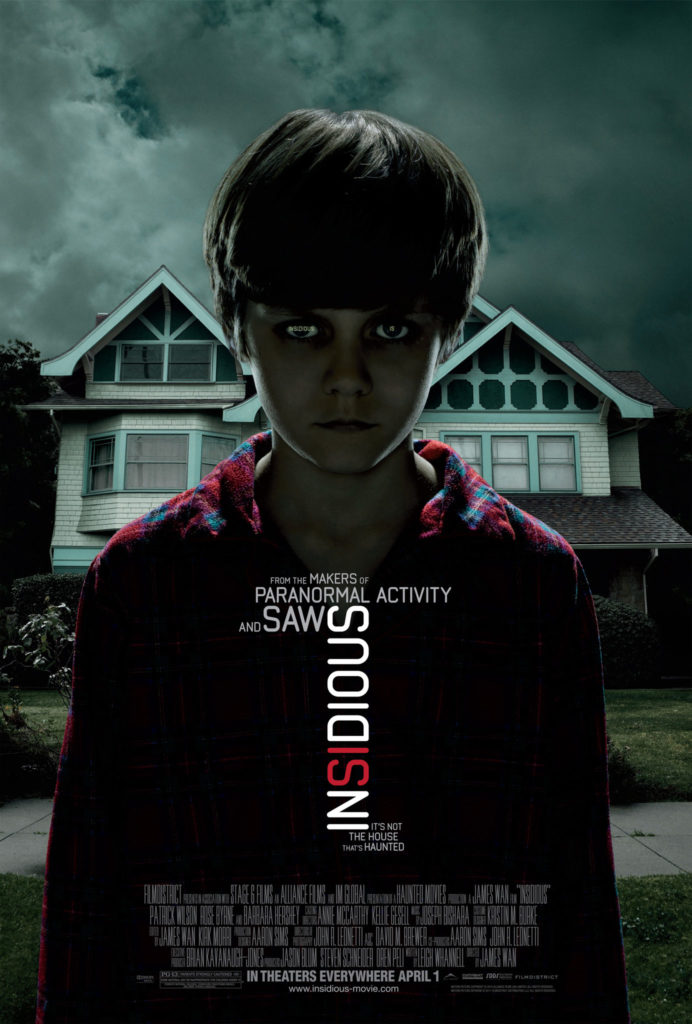 According to the IMDb page for Insidious, Leigh Whannell kept a list of horror movie clichés handy while he was writing the screenplay. He didn’t want his project to slip into the same predictable traps that mar so much horror cinema. With that list staring him in the face day in and day out, presumably, Insidious would turn out to be a film that was totally fresh, one that even audience members with hundreds of hours invested in the genre would find enjoyable. That is a very laudable goal, and a bit of a risk. Just because a film is formulaic does not mean it is a bad film. In its most basic sense, it just means the film will feel familiar to many people watching it. And as we all know, people like the familiar. As much as we like to pretend humanity is a collection of adventurous people, the opposite is in fact true. That’s why tourists eat at the same restaurants they have back home. It’s why popular music at times can sound like the same song done over and over again by a hundred different groups. And that’s why sequels, remakes, and carbon copies of previous successes make money at the box office. It’s just the way things are.
According to the IMDb page for Insidious, Leigh Whannell kept a list of horror movie clichés handy while he was writing the screenplay. He didn’t want his project to slip into the same predictable traps that mar so much horror cinema. With that list staring him in the face day in and day out, presumably, Insidious would turn out to be a film that was totally fresh, one that even audience members with hundreds of hours invested in the genre would find enjoyable. That is a very laudable goal, and a bit of a risk. Just because a film is formulaic does not mean it is a bad film. In its most basic sense, it just means the film will feel familiar to many people watching it. And as we all know, people like the familiar. As much as we like to pretend humanity is a collection of adventurous people, the opposite is in fact true. That’s why tourists eat at the same restaurants they have back home. It’s why popular music at times can sound like the same song done over and over again by a hundred different groups. And that’s why sequels, remakes, and carbon copies of previous successes make money at the box office. It’s just the way things are.
But, occasionally, as people are wont to do, someone gets it in their head to try something different. In this case, the result was a writer developing a horror screenplay while actively trying to avoid cliché.
Insidious tells the story of the Lambert family, headed by Josh (Patrick Wilson) and Renai (Rose Byrne). They’ve just moved into a new house, and it turns out that it may be haunted. The ghost, or ghosts, have targeted one of the children, Dalton (Ty Simpkins), leading him to descend into a permanent state of sleep. Renai is fairly in tune with what is happening to the family, while Josh remains a stubborn skeptic, despite all the ghostly shenanigans going on around them. Eventually, in a desperate attempt to save their child, the Lamberts invite a team of paranormal investigators, including a psychic, into their home to help. If this brief summary sounds familiar, that is because, with only minor modifications, it could be used to summarize Poltergeist, The Orphanage, Mama, The Haunting in Connecticut 1 & 2, and many, many others. Despite having a list of clichés to avoid while writing, Whannell somehow managed to miss that this plot has been done so many times that it is now a cliché as well. Thank goodness for him, then, that Insidious is one of the best horror films of the last decade.
As the film was helmed by James Wan, the man responsible (with Whannell) for the execrable Saw franchise, I didn’t have a lot of hope for this film when I first began watching it. But Wan thankfully ditches his torture porn pedigree for this one, instead preferring genuine frights over cringe-inducing gore. There aren’t any deadly devices or self-mutilation in Insidious. Rather, the audience is treated to atmospheric scares. Wan, like so many accomplished filmmakers before him, seems to have figured out that simply grossing out the audience is no way to build dramatic tension. Wan wields a deft hand over this film, maintaining an even keel with the story. In both slow and tight spots, nothing feels wasted. Every scene breathes life into the story.
All of the effort by Whannell and Wan could have been for naught if the film was stuffed with a bunch of bad actors. Considering Insidious had a budget of only a million and a half bucks, there was a good chance the producers wouldn’t have been able to afford anyone with either talent or experience. Alas, they were able to get both. Byrne and Wilson were good, and they were joined by Lin Shaye as the psychic, Elise. Her character swooped into the film to give her Tangina-esque assessment of the ghouls and goblins bedeviling the family, and in the process, Shaye almost stole the film.
Good ghost stories are hard to find. Mostly, I suspect, because they’re hard to get right. Insidious got it right.
